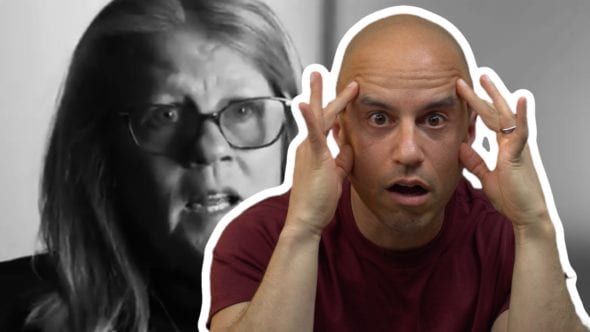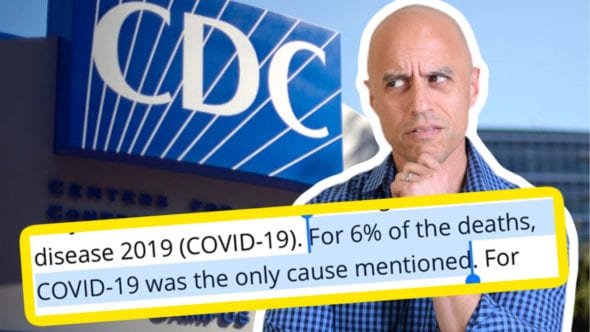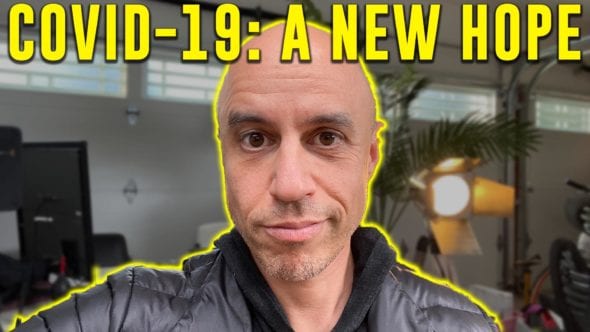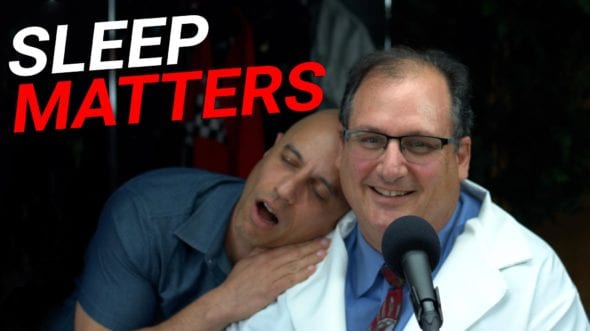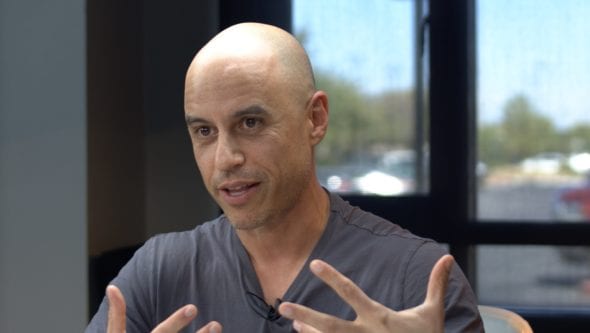Could herd immunity and an end to the pandemic be closer than we think?
What role does personal responsibility and masking play? A live discussion of a light at the end of the tunnel.
Here’s that Atlantic article. And here’s a short summary video you can share with everyone.
Transcript Below!
What is up everybody, it’s Dr. Zubin Damania AKA Dr. Z, AKA ZDoggMD, whatever. Hey today, I wanna talk about something I’m actually super excited about for the first time in forever. I am truly stoked about how this pandemic nightmare is gonna end.
And I’ll tell you why, when I first started talking about this stuff, I had this, I would say this publicly, there was these intuition that I had that this coronavirus type illnesses tend to burn out in a way that is really interesting. It’s not like influenza or something like that. It actually, they tend to suddenly get a lot better and it wasn’t clear why that was right? And especially now when we see cases surging and areas that hadn’t been hit heavily, getting hit very heavily and areas that had been hit a little bit heavily in the beginning but locked down quickly and did all of that now seeing surges that are much bigger, but then areas like New York that got hit very heavily early on now, not having many new cases and many new fatalities reaching a kind of an equilibrium and improvement.
Places like Italy and Spain that got hit very early and now we are seeing stability. And you could say, well, okay is this due to people locking down very aggressively, masking, social distancing, washing hands, getting tested. Yes, that’s all true. But what else could it be? And I wanted to talk about a new article in the Atlantic by James Hamblin, talking about herd immunity. Now herd immunity is something that we’ve been talking about quite a bit for many years in terms of vaccines. That’s where the term really originates. And this is the best way to think about it as we think about this pandemic.
Okay, ’cause we’re gonna talk today about herd immunity in the setting of coronavirus without a vaccine. And then what happens with the vaccine and how the number needed to reach herd immunity may actually be quite a bit less than initially thought and what that means for us, what it means for wearing a mask or not what it means for opening up or not what it means for schools or not what it means for dying potentially or not for our most vulnerable people. So let’s talk about herd immunity, and again, we’re live so bear with me as we hash this out together. Herd immunity, I prefer the term by the way community immunity, because what it means is, it means that when you have a infectious agent like a virus, it has to spread from person to person to person, to person to person to person. It turns out that if it has trouble finding a susceptible person who isn’t immune to the virus or is more resistant to being infected, it can easily spread. And what that does is it reduces what we call the R0 the R with the little zero next to it, of the virus.
In other words, how many people get infected from a single person that’s infected? So an R0 of one means, if one person is infected on average, he or she will infect another one person, which means that the total number of infected people doesn’t change it stays stable. If that R0 is less than one, then the infection starts to peter out because it’s infecting fewer new people than it initially infected. If the R0 is greater than one, then slowly it starts to grow. And if it’s a lot greater than one, as in coronavirus pandemic, like two, three, then you get these bursts of exponential growth in cases and if you have a virus like this where the fatality rate and we don’t know exactly what it is yet, and I’ve done videos on this, but let’s assume it’s in the range that people are speculating right now, between half a percent and one percent of everybody who’s infected will die. And that’s not counting the number of people who get really sick in ICU, who have complications that lead to longterm disability.
This is and the cost of all that. This is a serious disease, no matter what the hucksters will tell you, but it’s not something we need to catastrophize about, but it’s very serious. So with a disease like this, when you have enough people infected with the virus, they develop we assume, and there’s good reason to assume this, antibodies and immune system defenses that then prevent them from getting reinfected, at least in the near future. Maybe they get reinfected in a year, maybe they get reinfected in six months, but in the near future, they’re effectively immune from this virus. And there really isn’t no matter what you read online, there isn’t a lot of evidence right now of immediate reinfection of patients, people retest positive and all of this but we think that that is either persistent infection or fragments of virus that we’re picking up on our very sensitive tests that aren’t actually representing active raging infection or reinfection.
So let’s assume you get infected, you develop antibodies and you’re out of the game. You’re out of the pool that this virus can hunt when it’s looking for its next host, this zombie virus, right? So what does that mean? Well, it means that as we get more and more people who’ve been exposed and infected and develop antibodies, the virus has harder and harder time finding a new host. So the R0 starts to drop. It’s harder for one infected person to infect other people because they’re less susceptible targets around. Now we think about this in terms of vaccines in a really beautiful way. And this is why I think people who are against vaccines say, well what if I don’t get my vaccine, why does it hurt you? Why do you care what I do? My body, my choice right? Well, because it does affect us because it affects the community immunity. Because say for measles, you need to vaccinate about 90 to 94% of the population, to develop enough herd immunity, to protect people for whom the vaccine didn’t work some people don’t mount an immune response, or for whom they’re unable to be vaccinated for various medical reasons, particularly the very young and the very old, but by getting to 90 to 94%, that virus never can find enough of a stronghold to then jump to that susceptible person who’s kind of a target, can never get to the target because there’s enough blockade all around.
That’s the beauty of community immunity of herd immunity right. Now, we usually think about it then in terms of vaccination, if we vaccinate the community, we get enough community immunity that we protect our most vulnerable. Now what about coronavirus which currently doesn’t have a vaccine and we can talk about vaccine later, but we don’t have a vaccine now, could you develop herd immunity without a vaccine through natural infection? Now this is where we have to be very careful because there are people who have advocated just let this thing run wild through the population and we’ll develop herd immunity and the problem will solve itself naturally the way pandemics have solved themselves throughout history before we had modern medicine.
Now here’s the problem with that, what is the percentage of people that need to be infected in order to develop community immunity with coronavirus. Early projections based on early data that made an assumption. And the assumption was this, that coronavirus herd immunity behaved in a similar way as vaccine herd immunity. In other words, people had a predictable and similar susceptibility to the virus and they had a predictable and similar immune response to in this case a vaccine. So they said okay, so for coronavirus, let’s assume everybody is perfectly susceptible because it’s a brand new virus that configuration of a coronavirus that humans haven’t really seen. So therefore, they’re all gonna be equally susceptible, there’s going to be zero immunity. They’re all gonna get it if exposed at any dose, whatever the threshold dose is and let’s make our calculations as what community immunity needs to be. And it turns out that those calculations were somewhere in the 70% range or higher. If 70% of the population got infected, and let’s say 1% of them died on average across ages remember it’s much worse in the elderly than it is in the young.
That is a massive death toll, tens of millions of people worldwide. So the cost of natural community immunity at a 70% herd immunity threshold is devastating. And I think it’s very hard to argue that you could just allow that to happen. But what ended up actually happening is really, really interesting and it has to make us rethink the concept of herd immunity in coronavirus, because it turns out coronavirus susceptibility is not uniform. Your susceptibility to coronavirus may differ dramatically from mine and differ dramatically from somebody else’s based on what? Based on your age, based on your other diseases that you have, chronic diseases, diabetes, hypertension, lung disease, obesity, those kinds of things, inflammatory diseases, immune compromise, based on your ethnicity and there’s thoughts on genetic susceptibility.
There’s thoughts on ACE receptors there’s a million scientific proposals for why there may be a differential susceptibility in populations, but the bottom line is there is. And so as a result, this virus from the beginning has behaved in an interesting way. You will have a rapid rapid rise in infections, which we’ve seen Italy, Spain, Wuhan, Singapore, New York city followed by a tapering off and then decline that is quite rapid. And then you do antibody prevalence testing. What does that mean? It means testing the population for who might have been exposed to this virus, knowing that 40 to 80%, depending on your situation of people who are infected have no symptoms or have very mild symptoms that they don’t even really report or notice. So if that’s the case, you can test antibodies and go, okay, depending on the accuracy of the test, which we’ve done videos on, how many people have been exposed, well in New York, some of the estimates range as high as 20 to 25% of New Yorkers have already gotten this virus or been exposed to it at some level, even if they’ve never had symptoms.
And it turns out that the calculations. So in other words, we’ve only reached 20% and yet infections have done this. So is that due purely to hand washing, social distancing, mask wearing, they undoubtedly contributed because New Yorkers are doing much better with that stuff since they saw the devastating effects of the virus, but there’s something else going on. And it turns out in this article, they described the research of a group in Glasgow, Scotland that looked at these numbers and said, all the curves are not consistent with everyone being equally susceptible and herd immunity developing at a 60, 70% threshold. They look more like a less than 20% herd immunity threshold. And you go, wait what! So you’re saying only 20% in this estimation by and this is by the way, just one estimation, but she has some data to support this. There’s others who think it may be more like 20 to 40 to 50%, but let’s assume 20% is right. If 20% of the population gets infected, why the heck would the virus peter out?
You haven’t reached any kind of herd immunity. But here’s the thing, what happens in that first 20% is you are rapidly infecting and depleting a pool of the most susceptible people. So the elderly, we saw this nursing homes et cetera, people with chronic disease, people who have genetic susceptibility, people who are really not social distancing and work in very dangerous environments, meat packing, health care, those sort of tribes got high viral dose exposures, had high susceptibility potentially some of them genetically and otherwise, and rapidly got infected, just pandemic, chaos, death, high fatality rate disaster, right? And people thought assumed a linear extrapolation that this was going to continue until either everybody was infected or we got a vaccine. But what actually happened? You deplete the pool of susceptible individuals now, the R0 of the virus has to drop because it can’t find targets. The targets that are left are less susceptible why? Genetics, age, whatever they’re wearing masks, they’re washing hands, they’re not crowding into places unnecessarily, but they’re still out in the world. And what ends up happening that pool of less susceptible people is not an affective target for the virus.
So what ends up happening? The virus starts to peter out, it cannot find hosts that doesn’t mean it disappears. It means we go from something where the virus is pandemic everywhere growing to endemic. It’s at a low level in the population finding targets of opportunity where it can like a seasonal flu or a cold or something like that. But the rest of the population acts as a herd protector in general, for vulnerable people along with some common sense maneuvers like hand washing, et cetera, et cetera, et cetera. So if that’s true, the Glasgow studies seem to suggest that a threshold of 20%, well, what happened in New York, you reach 20%, and now we’re seeing hardly any new cases compared to say, Florida that never had that initial surge and now is, or California that initially didn’t have the massive surge, but now we’re seeing it. So this is fascinating you guys, because what does it tell us?
It tells us that this thing behaves in a more complex dynamic in a dynamic way, not a linear way. And it tells us so the fatalist would say well, then let’s let it run through the population. You can still get sick even if you are less susceptible, if you’re faced with a high viral load, a bunch of virus in your face, someone coughing asymptomatic in your face on a subway without a mask and people who are vulnerable can still be hurt. So how do we bend that herd immunity number down lower. This is in our control. It doesn’t mean we shut down the economy it doesn’t even necessarily mean that we shut down the schools. It may simply mean this, wear a mask when you can’t socially distance. And why, why? Because of this, you wanna reduce the pool of susceptible individuals. How do you do that? If everybody universally masks and remember my thinking has evolved on this as more data has come out, the mask prevent you from spraying other people with a lot of viral particles.
But the other thing masks do that we don’t talk about enough is they lower the amount of viral particles that you actually inhale. Why is that important? For the reasons I just talked about if you’re one of those people that isn’t absolutely susceptible to this in a very sensitive way, a few viral particles through a mask and there is a lot of emerging data to support this, which I’m gonna do a separate video on. A few viral particles through a mask, may lead you to have an asymptomatic infection that ultimately leads to immunity that you could then spread while you’re infected though you don’t know it, but if you’re wearing a mask, you’re much less likely to spread it and it is gonna then generate more herd immunity and if you don’t get infected, then you’re avoiding the virus through another screen.
And you’re increasing the effectiveness of the current herd immunity. Throwing a dumb mask on is not a whole lot of drama when you’re in a close tight space and you can’t socially distance, that’s not asking a tremendous amount of people. What’s asking a tremendous amount of people is close down the schools, shut down the economy, close all the restaurants do all of this. You don’t probably have to do that if this data is true, it means that we can do our part to reach herd immunity in a safe way that doesn’t cause as much death among vulnerable people. Now here’s a really important point. The difference between a 60% herd immunity threshold, which might be needed if everyone’s coughing in each other’s face, not wearing a mask, not social distancing, behaving like jackasses. 60% versus 20% worldwide at a mortality rate of 1%. That’s like 30 million deaths that you avoid by having that threshold be 20%. This is mind blowing. This is the best news in the history of this pandemic, because if it’s true and I’m telling you, look at Italy, look at New York, look at places that were hit hard and then mast up.
They’re doing pretty good, right? So there’s a lot of emerging evidence that this may well be correct. What it says is, hey, pick up after yourself, throw on a mask, social distance, wash your hands, get tested if you think you have symptoms and self quarantine, we don’t need to destroy our way of life to do it. We don’t need to think about 60 and 70% herd immunity thresholds, right? And if we get across that vaccine finish line, then you vaccinate the crap out of it. And then you have herd immunity and then this thing may be gone. Or if it’s one of those things where the immunity only lasts a year, let’s say okay, every year you get your coronavirus shot, like you get your flu shot.
And we keep it under control, especially in our most vulnerable people. And we live with another virus that doesn’t ruin us, we stop catastrophizing. We stop politicizing on both sides of this idiocy that we’re doing. And we move the hell on. It’s not rocket science although the science and mathematics that goes into the chaos theory that predicts this declining herd immunity threshold is complex. That’s why we should listen to the scientists, but also don’t let the scientists catastrophize. We need to make rational decisions based on economics, social disruption, and the science, which means we have to listen to all those groups. All right, this is huge. If it’s true let’s read some comments.
Do you say that the earth then can reach herd immunity at 20% infection rates? Crystal Ivy. Well, we don’t know because we don’t have enough data, but assuming that there’s a variety of susceptibility to the virus in humans throughout the earth, let’s say if that herd threshold is 20%, if 20% of all humans got infected naturally, the pandemic would peter out and you would just have this low brewing, occasional infections. And that would be one way that it ends, but more likely what happens is people step up, they mask up, they socially distance and actually they bend that threshold lower so that the viral reproduction drops, we get to a vaccine and then less people have to die. That’s assuming a vaccine is possible, which preliminary evidence is suggesting it is.
It just may take longer than you think. And in that time, you don’t want a ton of people to die, but at the same time, listen this is so important, you don’t want the cure to be worse than the disease! Why would you cause famine, joblessness, suicide, substance abuse, child abuse, a generation that’s even more poorly educated than baseline. I mean, we can’t critically think now, imagine our children’s sitting at home playing Xbox or twiddling on their Chromebook that the school scrimped and saved with their low budget to try to give them with the crappy distance learning they’re getting, they need to be together and socialized and learning and of course we need to transform education, we need to pay teachers better we need to keep them safe. But all those things cause massive devastation and harm vastly worse than the virus might be. So we have to weigh that and go, okay, if that’s true with this data that’s emerging, what can we do that can get us across the finish line without destroying everything, wear a mask, everybody in locations where you can’t socially distance wash your hands, and if you have symptoms get tested, really that’s gonna be enough that isn’t too much to ask.
It’s really not for some peoples up no, it is! I can’t reach you except to say that here’s the finish line, we could get over it a lot faster if everybody just did that one thing, we could just open everything up again. So that’s what this video is really about. It’s thinking about herd immunity. Now, let’s talk about that mask thing again, the masking if it’s lowering that viral threshold, it’s doing a lot of good because it means less severity of these and there’s evidence for this. So there’s cruise ship evidence, where there was a cruise from Argentina to Antarctica. And as people got infected on that, they masked everybody up. n95 for the crew, surgical mass for the travelers. They had an 81% asymptomatic rate of people who got infected. So they still got infected ’cause not social distance in a enclosed, non poorly ventilated thing, but they were asymptomatic, which means whatever dose of virus they got was lower. And so they developed an immune response without getting so sick that they had to be hospitalized or worse. So this is important stuff.
So on that note let’s see here, Shabnan Pilsaq says, it’s hard to get asymptomatic people to be contagious enough to spread the virus. Generally it’s presymptomatic people who spread the virus. So we don’t know that for sure, asymptomatic and presymptomatic the differences of course you don’t have any symptoms now, but then later you develop them. But even asymptomatic people, might well spread virus, but it’s less likely. And if they’re wearing a mask, likelihood drops dramatically. ‘Cause again, they’re shedding less virus. And there’s a lot of data that shows that the initial amount of virus does correlate to how severe a case you get. They looked at influenza so they infected healthy volunteers with influenza. The higher dose has had worse symptoms, worse cough, worse fevers, and those kinda things. So, this is probably a real phenomenon. All right guys, you know I love you do me a favor, share this video I’ll put it up on YouTube and all that. Tell your friends, just do these three things and the finish line is near because I think people don’t wanna be told to wear a mask forever.
When is this gonna stop? Well, the easiest end point is you get a vaccine and you start vaccinating people, but knowing Americans in particular, they’re so anti-science, so pro conspiracy that we’re never gonna to reach 90% compliance with the vaccine, but I bet we could get it 60, 70%. And if that’s enough for herd immunity given otherwise decreased susceptibility in the remaining population that might be very effective. So looking forward to that, that might be an end point. Then we just have seasonal stuff where the culture might need to change. If you have symptoms of something, throw a mask on like they do in Asia seems to work pretty freaking good. All right, guys, I love you hit share. Thank you to all the supporters of this show who signed up on Facebook or YouTube to support this show financially and get exclusive content. And we are out check us out on Instagram too. It’s dope peace.
Category
- The ZDoggMD Show (818)
- Featured Videos (189)
- Doc Vader (142)
- Against Medical Advice (128)
- Medical Humor (95)
- Public Service Announcements (87)
- Music Parodies (74)
- Nurses (59)
- Meditation (46)
- The VPZD Show (38)
- ZVlogg (36)
- ZTalks (28)
- ZBlogg (24)


